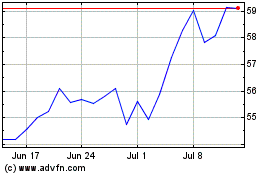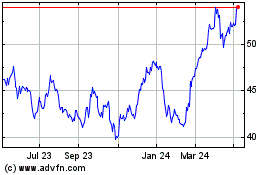LLOYDS BANKING
Restructuring, Bond Buybacks Hurt Profit
Lloyds Banking Group PLC said net profit fell sharply in the
first quarter, hit by restructuring charges and the cost of buying
back high-interest-paying bonds.
The British retail bank, which is about 9% owned by the U.K.
government, said revenue dropped 1% to GBP4.4 billion ($6.4
billion), while profit fell 44% to GBP531 million. Shares fell 1.7%
in London on Thursday.
Like other lenders, Lloyds has been struggling as low interest
rates eat into profitability. The bank said it was accelerating
cost-reduction plans, while ratcheting back mortgage lending as the
U.K. buy-to-let mortgage market starts to cool. Lloyds will review
its three-year strategy, launched in 2014, should it hit
cost-saving targets ahead of time, said Chief Financial Officer
George Culmer.
Lloyds took a GBP790 million hit buying back
high-interest-paying bonds it issued to investors during the
crisis.
This helped improve the bank's closely watched net interest
margin -- the difference between its cost of borrowing and the
price at which it lends -- to 2.74%.
--Max Colchester
BBVA
Currency, Trading Woes Slam Results
Banco Bilbao Vizcaya Argentaria SA reported a 54% drop in
first-quarter net profit, dragged down by currency turmoil, weaker
trading income and higher costs.
BBVA, Spain's second-biggest bank by market value, said net
profit in the first quarter was EUR709 million ($802.8 million), a
long shot from the EUR840 million that analysts had been expecting,
according to a poll by data provider FactSet. Its shares fell 6.8%
in Madrid.
"This set of results shows some weakness in revenues, especially
in Spain," Kepler Cheuvreux analyst Alfredo Alonso wrote in a
research report.
First-quarter net profit in 2015 had been high -- EUR1.54
billion -- boosted by BBVA's partial sale of a stake in a Chinese
lender. That made a comparison with the first quarter of this year
unfavorable from the get-go. But even excluding that impact, BBVA's
net profit would still have fallen 26%, Chief Executive Officer
Carlos Torres Vila told analysts on a conference call. Much of that
decline was driven by declines in currencies against the euro, he
added. BBVA has units from Mexico to Turkey and reports its
earnings in euros.
Net interest income was EUR4.15 billion, compared with EUR3.66
billion a year earlier. That also came in below analysts'
expectations of EUR4.3 billion.
The first quarter, Mr. Torres Vila told analysts, "has been an
abnormally low quarter in terms of earnings."
While results were "well below" what investors had anticipated,
Mr. Torres Vila acknowledged, the nosedive in the share price was
also partly a market correction following a strong stock
performance this year, he later told journalists. Some analysts
concurred.
BBVA's bank in Mexico, Bancomer, is the biggest driver of
profit. Net profit there declined to EUR489 million in the quarter
from EUR525 million a year earlier.
A decline in oil prices hit the Mexican peso hard in the first
quarter. Mexico relies on oil revenue to finance a large portion of
its annual budget.
"Despite low oil prices, [there's] no signs of credit stress as
the nonperforming loan ratio remains flat" quarter-on-quarter,
Bernstein analyst Johan De Mulder pointed out in a research
report.
BBVA's results in South America were weakened by currency
upheaval, too.
In Argentina, the peso has fallen sharply since December, when
newly-elected President Mauricio Macri unshackled the currency from
government controls to attract investors. Also, the Venezuelan
currency fell 72% in the first quarter of this year compared a year
earlier.
High inflation in those two countries also pushed BBVA's costs
higher in the region.
For BBVA's Spanish banking unit, executives painted a bleak
outlook as lenders in the country battle negative interest rates,
historically sluggish demand for mortgages and stiff competition on
business loans.
Spain's third-largest lender CaixaBank SA also reported a
decline in lending income on Thursday, further dimming the outlook
for Spanish banks. CaixaBank shares were down 3.5% in late
afternoon trading in Madrid.
"Loan volumes in Spain have not performed well," BBVA CFO Jaime
Sáenz de Tejada told analysts. It will be more of challenge to grow
total loan volume in Spain this year than executives had initially
anticipated, he added, as the rate at which borrowers repay their
existing loans continues to outpace the rate at which other
borrowers take out new loans.
Borrowers in the public sector in particular, Mr. Sáenz de
Tejada said, are deleveraging.
An 18% increase in costs in the Spanish banking unit was driven
by the incorporation of bailed-out Spanish lender Catalunya Banc in
April of last year. That helped to push up costs overall at BBVA in
the first quarter compared with a year earlier.
Trading income plummeted in Spain, which the bank attributed to
a "very complex quarter" in the markets. BBVA's Spanish banking
unit saw a decline in first-quarter net profit to EUR234 million
from EUR307 million.
The weak results in Spain are one factor likely to drive
downgrades on analysts' expectations of BBVA's earnings, Citigroup
analyst Stefan Nedialkov wrote in a research note Thursday. "BBVA's
performance is in stark contrast to Santander's beat yesterday,
especially in Spain," Mr. Nedialkov added.
On Wednesday, Spanish peer Banco Santander SA reported a 5%
decline in first-quarter profit on weaker lending and fee income,
as currency turmoil from the U.K. to recession-hit Brazil squeezed
profits. Analysts had expected weaker results and Santander's
shares closed up 1.6% on Wednesday in Madrid.
BBVA's U.S. unit saw a plunge in net profit in the first quarter
as the bank hiked loan-loss provisions as the decline in oil prices
has hit energy as well as metals and mining companies. "It has been
a bad quarter in the U.S.," Mr. Torres Vila said.
BBVA reported a slight increase in its capital ratio to 10.54%
as of March 31, under international regulations known as "fully
loaded" Basel III criteria. Mr. Torres Vila said the bank planned
to reach an 11% "fully loaded" ratio sometime next year.
Like other lenders, Lloyds has been struggling as low interest
rates eat into profitability. The bank said it was accelerating
cost-reduction plans, while ratcheting back mortgage lending as the
U.K. buy-to-let mortgage market starts to cool. Lloyds will review
its three-year strategy, launched in 2014, should it hit
cost-saving targets ahead of time, said Chief Financial Officer
George Culmer.
--Jeannette Neumann
(END) Dow Jones Newswires
April 29, 2016 02:47 ET (06:47 GMT)
Copyright (c) 2016 Dow Jones & Company, Inc.
Lloyds Banking (LSE:LLOY)
Historical Stock Chart
From Mar 2024 to Apr 2024

Lloyds Banking (LSE:LLOY)
Historical Stock Chart
From Apr 2023 to Apr 2024
